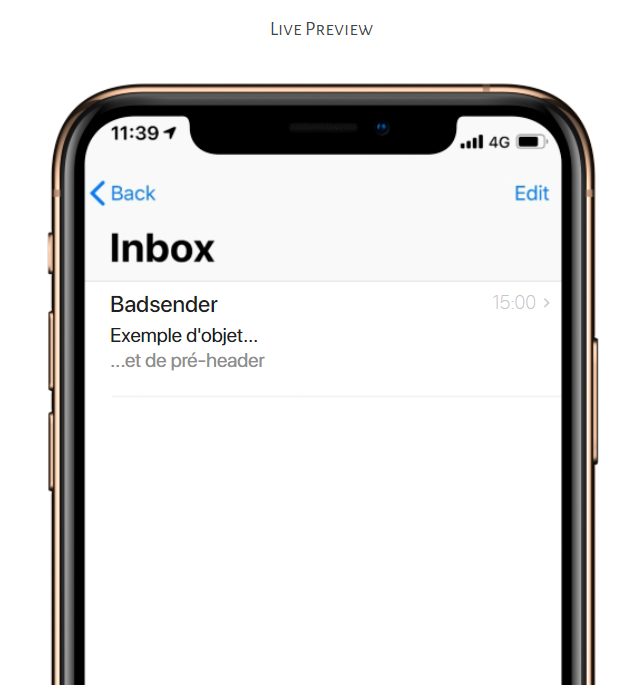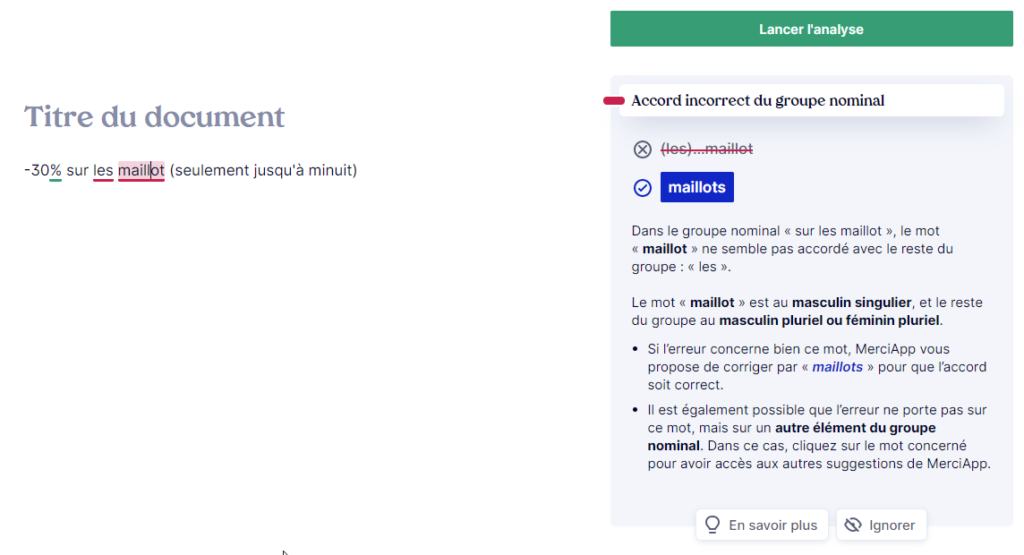GUEST ARTICLE
The emailing and newsletter writing is not trivial. Writing an email subject line that stands out from the crowd, arouses curiosity, is fair in relation to the content of the email and therefore makes people want to open it is not as easy as it sounds.
What strategies do email marketing professionals have at their disposal to develop objects that work?
We've listed six strategies that work (almost) every time, along with real-life examples. Enjoy reading!
The basic rules to respect concerning the objects
Before developing our six strategies, let's recall some basic writing rules which apply to any newsletter.
Rule 1: size matters
54 % e-mails are now open on mobile.
It is imperative to have items with important elements visible on any type of device: computer, tablet or smartphone.
To make sure you stay on track, I recommend this site which allows you to preview your object (and your pre-header) on recent mobiles.
Rule 2: Optimize the pre-header too
Optimizing your object is good. Optimizing your object and its pre-header is better!
What is the pre-header?
This is the preview text displayed by most email clients and gives your readers an additional taste of the content of your email. Think of it as one more opportunity to convince your recipients not to throw your email in the trash.
Rule 3: don't limit yourself to analyzing the opening rate
When analyzing the results of an email campaign, it is important to look at the performance of the email as a whole :
- deliverability rate What proportion of recipients received the email?
- opening rate What proportion of the people who received it opened it?
- reactivity rate How many of the people who opened it clicked on a link?
- conversion rate What proportion of the people who clicked buy?
Analyzing all these factors together avoids a rookie mistake: isolating metrics without seeing their relationships to each other.
Let's take a simple example.
I use a very mysterious object that makes my subscribers want to open my newsletter. The open rate is very high. Unfortunately, most of the openers are disappointed with the content and do not click. My newsletter finally generates a very low turnover. This very high opening rate is not in itself a sign of success, since in the end, ushers are disappointed and do not buy.
Rule 4: Respect the spelling
I know.
You may have suffered from dictations in your youth. Since then, you've been struggling with spelling and grammar. Unfortunately, your subscribers are probably very strict about spelling.
Do them a favor and take the time to correct your mistakes: GoodPatron (free service) or MerciApp (freemium service) are there for you!
It would be a shame to start off with a bad impression.
Come on, after this detour through spelling, let's get back to the point: newsletter objects.
And let's start with the most common strategy.
Strategy 1: Follow the school method
The principle of the school method:
This method is as easy as pie. It consists in describing (coldly) by the menu what the newsletter contains.
It is very often found among luxury brands (which cannot take the risk of using objects that are too eccentric) and among marketplaces (which must be precise about the content of their e-mails because their base is so large and their subscribers have varied interests).
Personally, I did emailing at Rakuten for 2 years. We applied this method to the letter for all our newsletters.
Examples of objects applying the school method:
As you can see below, no risk-taking at A.P.C. and Lacoste (luxury players) and Brandalley (marketplace). By reading the subject line, we know exactly what the newsletter is going to offer us.
Advantages/disadvantages of the school method:
- Benefits With this method, we play it safe: no originality that might offend the subscriber or create confusion. This type of subject line has the advantage of avoiding unpleasant surprises for the openers. The person who opens your email knows what to expect.
- Disadvantages These objects can be tiresome, especially for a subscriber who receives many newsletters of the same type. Eventually, your open rate may suffer.
Strategy 2: Try the mystery method
Principle of the mystery method:
The mystery method remains a classic. It consists in saying as little as possible. Not enough to really understand what it is about and enough to make you want to open the e-mail.
Examples of mysterious objects:
With "En route!", Lancel says very little about the content of its newsletter, while 3suisses teases the subscriber with a crisp "True story". Two objects that say little about what you will find when you open the newsletter.
Advantages/disadvantages of the mystery method:
- Benefits This type of strategy breaks the monotony of commercial newsletters and captures the attention of subscribers. It often allows to obtain a good opening rate.
- Disadvantages The use of mysterious objects remains a risky strategy and you risk creating disappointment among the openers. In the end, if the disappointment is too great, the number of clicks will be low. And if this bad performance is repeated, you risk losing your subscribers forever.
Strategy 3: Make nods to pop culture
Principle of the pop method :
With this strategy, we go off the beaten track a bit, with a humorous object. The principle is simple: the subject of the newsletter is based on a pop culture reference, such as the title of a song or a movie. The idea is to evoke a familiar element, while creating a shift.
Example of a Pop culture object:
With this object which takes the title "Parti un jour" of the boy band 2 be 3, Asphalte makes a strong wink to the thirty-year-olds who were traumatised marked forever by the group.
Advantages/disadvantages of the pop method:
- Benefits With these objects, you are guaranteed to attract the attention of your subscribers and activate a positive reaction.
- Disadvantages As with the mystery method, there is a risk of disappointment at the end. Additional difficulty: this kind of object requires a real creative talent and a lot of thought beforehand.
Strategy 4: Play on emotions
Principle of the method emotions :
With the "emotion" objects, we will try to pique the subscriber's interest by appealing to their emotions or to his deepest convictions.
Examples of emotional objects:
The first example, from an email sent by responsible clothing brand Faguo, is typical. It touts a product that engages against climate change.
The second one sent by L214, an association that campaigns for animal welfare, uses an alarmist tone and mentions a countdown. These two elements guarantee an echo among people sensitive to the association's cause.
Advantages/disadvantages of the emotional method :
- Benefits If the emotion is consistent with the brand identity, you have every chance of maximizing your number of e-mail openings.
- Disadvantages The exercise remains risky, especially for brands. Faguo's email, for example, could be accused of greenwashing and generate the opposite reaction to the one expected.
Strategy 5: Use an inspirational object
Principle of the inspirational method:
This method is a derivative of the mystery method (as a reminder, the objects where we say as little as possible about the content of the mail). The difference is thatHere we refer specifically to a positive concept.
Examples of inspirational objects:
With "beautiful days", "a scent of summer", "take to the sea", the emails below refer to seasons, concepts and positive aspirations. These items remain vague (no pun intended for Jules & Jenn), but inspire something positive and calming.
Advantages/disadvantages of the inspirational method:
- Benefits This type of subject line associates the email with a positive emotion and puts your subscriber in good conditions for the future.
- Disadvantage As with the mystery shopping method, it is not always easy to make the link with products to sell or with a message to pass on.
Strategy 6: Play on FOMO
Principle of the Fomo method :
What is FOMO?
It is the panic fear of missing something.
Wikipedia
In emailing, you can exploit this trend by playing on the urgency or on limited quantities to convince to open and buy. This is a strategy that is most often found at the time of sales or with sites specialized in flash and private sales.
Examples of FOMO objects:
Clearly, we need to have a cool head to not succumb to the alarmist items below. "The end", "last hours" or "limited stock" are all items that play on our anxiety of missing out on something unmissable.
Advantages/disadvantages of the FOMO method:
- Benefits Experience has shown that these objects generate the best open rate.
- Disadvantages Be careful not to tire your subscribers with one FOMO email after another. Stress doesn't work every time.
And here are your 6 strategies. And you, which one is your favorite strategy for your newsletters objects? Mystery? FOMO? Emotions?
From our side, we recommend alternating between different types of objects to avoid tiring your base.

















